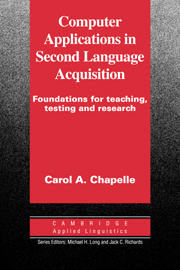Book contents
- Frontmatter
- Contents
- Series editors' preface
- Thanks
- Abbreviations
- 1 Historical foundations of CASLA
- 2 The context and challenge for CASLA
- 3 Computer-assisted language learning
- 4 Computer-assisted language testing
- 5 Computer-assisted SLA research
- 6 Directions for CASLA
- References
- Author index
- Subject index
5 - Computer-assisted SLA research
Published online by Cambridge University Press: 05 October 2012
- Frontmatter
- Contents
- Series editors' preface
- Thanks
- Abbreviations
- 1 Historical foundations of CASLA
- 2 The context and challenge for CASLA
- 3 Computer-assisted language learning
- 4 Computer-assisted language testing
- 5 Computer-assisted SLA research
- 6 Directions for CASLA
- References
- Author index
- Subject index
Summary
Computer-assisted SLA research ideally complements research and development of CALL and CALT by offering results pertaining to questions about instruction and assessment. A computer-assisted second language research (CASLR) task is defined as one in which learners are expected to work on the target language interactively with a computer program or with other people through the medium of the computer. Such tasks may appear to the learners to be a regular part of instruction or testing, or they may be explicitly introduced to learners as research tasks. One type of CASLR is to gather evidence about the effects of instructional conditions of learning, as illustrated in a study by de Graaff (1997a), who compared the effects of implicit and explicit instruction by operationalizing each condition through CALL. A second type of CASLR is used for assessment, i.e., to make inferences about aspects of learners' language ability and learning (e.g., vocabulary, metacognitive strategies). Such tasks fall within the purview of assessment and are therefore discussed in the terms introduced in Chapter 4. One example of a CASLR task used for assessment was designed by Hulstijn (1993) to assess learners' vocabulary look-up strategies during reading. In both assessment and learning condition CASLR, past work exemplifies research methods and points to future research.
- Type
- Chapter
- Information
- Computer Applications in Second Language Acquisition , pp. 132 - 156Publisher: Cambridge University PressPrint publication year: 2001



